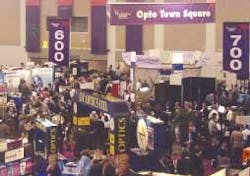Attendance and morale rebound at Photonics West 2004
Photonics West 2004 was marked by a boost in both attendance (14,600, up from 12,300 in 2003) and exhibit-floor morale compared to the last couple of years. Particularly notable was a 20% increase among exhibitors of biomedical optics (BiOS), which brought the total number of exhibitors to a record high of 800. The BiOS exhibit consisted of companies displaying a range of applications that included tungsten light sources for use in spectroscopy applications, optical software for use in medical-imaging systems, and optical filters and coatings for applications such as 35-mm photomicroscopy, absorption microscopy, and DNA sequencing.
The technical program began on a Saturday morning with the BiOS Symposium and a BiOS Hot Topics session that same evening. The increasing role and promise of optics in ophthalmology, noninvasive tissue biopsy, and functional imaging of physiological processes were major themes (see related supplement on biomedical optical imaging, which follows p. 76).
In giving the keynote address at the Hot Topics session in the symposium on Lasers and Applications in Science and Technology (LASE), George Miller, associate director for National Ignition Facility (NIF) Programs at Lawrence Livermore National Lab (Livermore, CA), discussed research at the NIF complex, which has completed the first phases of its laser-commissioning program, with the first four beams generating 106 kJ of infrared light and more than 16 kJ at the 351-nm third harmonic. Target experimental systems are being commissioned and experiments have begun, Miller said. Potential enhancements include green laser operation and high-energy short-pulse operation.
Topics of interest in the Integrated Optoelectronics symposium ranged from the increasing differentiation between the growing use of high-power light-emitting diodes (LEDs) as sources of illumination and the traditional use of LEDs as indicators, to improvements in designing efficient nonlinear light generation characteristics into quantum-cascade lasers for applications such as remote sensing of atmospheric gasses.
During the Micromachining and Microfabrication symposium, Farzad Pourahmadi, COO of Microfluidic Systems (Pleasanton, CA) discussed the development of MEMS (microelectromechanical systems)–based integrated systems for biowarfare-defense applications such as continuous air sampling, in which everything from sample preparation through optical-detection steps are carried out automatically.

